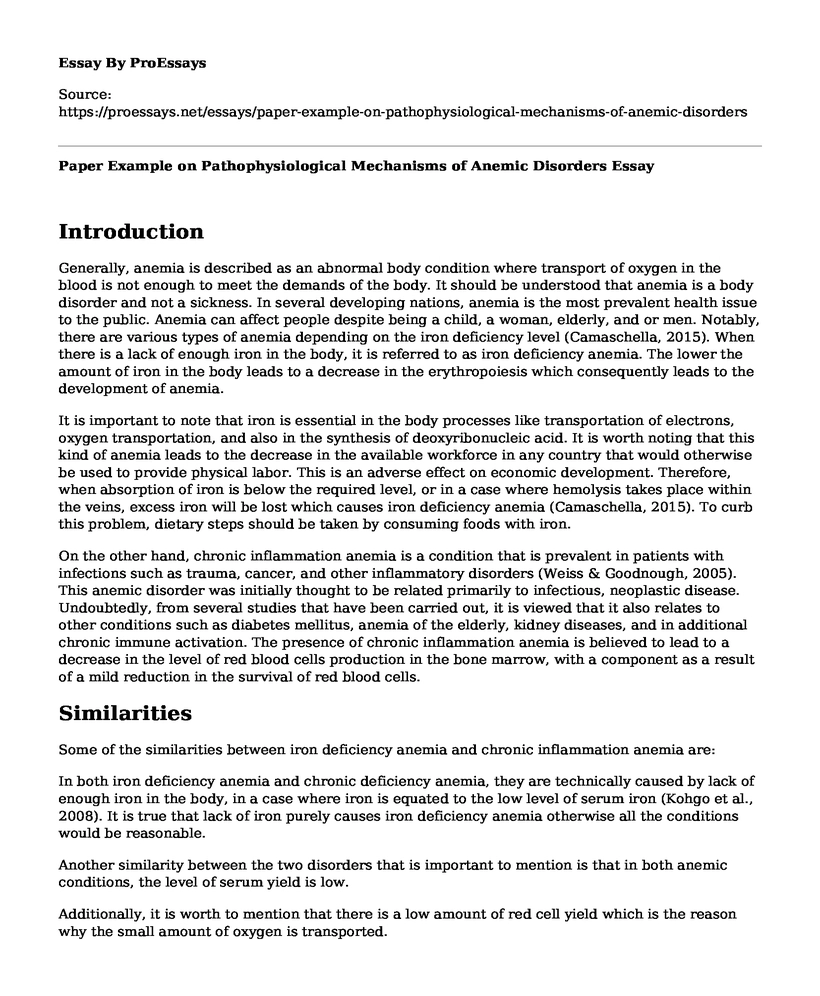Introduction
Generally, anemia is described as an abnormal body condition where transport of oxygen in the blood is not enough to meet the demands of the body. It should be understood that anemia is a body disorder and not a sickness. In several developing nations, anemia is the most prevalent health issue to the public. Anemia can affect people despite being a child, a woman, elderly, and or men. Notably, there are various types of anemia depending on the iron deficiency level (Camaschella, 2015). When there is a lack of enough iron in the body, it is referred to as iron deficiency anemia. The lower the amount of iron in the body leads to a decrease in the erythropoiesis which consequently leads to the development of anemia.
It is important to note that iron is essential in the body processes like transportation of electrons, oxygen transportation, and also in the synthesis of deoxyribonucleic acid. It is worth noting that this kind of anemia leads to the decrease in the available workforce in any country that would otherwise be used to provide physical labor. This is an adverse effect on economic development. Therefore, when absorption of iron is below the required level, or in a case where hemolysis takes place within the veins, excess iron will be lost which causes iron deficiency anemia (Camaschella, 2015). To curb this problem, dietary steps should be taken by consuming foods with iron.
On the other hand, chronic inflammation anemia is a condition that is prevalent in patients with infections such as trauma, cancer, and other inflammatory disorders (Weiss & Goodnough, 2005). This anemic disorder was initially thought to be related primarily to infectious, neoplastic disease. Undoubtedly, from several studies that have been carried out, it is viewed that it also relates to other conditions such as diabetes mellitus, anemia of the elderly, kidney diseases, and in additional chronic immune activation. The presence of chronic inflammation anemia is believed to lead to a decrease in the level of red blood cells production in the bone marrow, with a component as a result of a mild reduction in the survival of red blood cells.
Similarities
Some of the similarities between iron deficiency anemia and chronic inflammation anemia are:
In both iron deficiency anemia and chronic deficiency anemia, they are technically caused by lack of enough iron in the body, in a case where iron is equated to the low level of serum iron (Kohgo et al., 2008). It is true that lack of iron purely causes iron deficiency anemia otherwise all the conditions would be reasonable.
Another similarity between the two disorders that is important to mention is that in both anemic conditions, the level of serum yield is low.
Additionally, it is worth to mention that there is a low amount of red cell yield which is the reason why the small amount of oxygen is transported.
Differences
It should be understood that the main difference between the two is that iron deficiency is a type of anemia that occurs as a result of massively reduced iron level in the blood. On the other hand, chronic inflammation anemia is as a result of lack of enough hemoglobin in the blood to help transport enough oxygen required to maintain all the body processes.
Impact of Age
It cannot be downplayed that there is some interest in the genetic risks related to the age of various individuals regarding anemic disorders (Kohgo et al., 2008). It has widely been observed that the number of cell divisions during the process of spermatogenesis alongside their rate of wearing out related to oogenesis will highly favor genetic risks in the offspring of aged men. However, on some dominant disorders that affect some specific genes, the child risk of being affected increases with an increase in the age of the parent during birth. From some observed information, there exists a positive relationship in the age of the parents and the gene mutations. Also, various studies on gene sequences on the affected children and the parents would enable to get more information on the effects of age on the anemic disorders.
Reference List
Camaschella, C. (2015). Iron-deficiency anemia. New journal of medicine, 372(19), 1832-1843.
Kohgo, Y., Ikuta, K., Ohtake, T., Torimoto, Y., & Kato, J. (2008). Body iron metabolism and pathophysiology of iron overload. International journal of hematology, 88(1), 7-15.
Weiss, G., & Goodnough, L. T. (2005). Anemia of chronic disease. New Journal of Medicine, 352(10), 1011-1023.
Cite this page
Paper Example on Pathophysiological Mechanisms of Anemic Disorders. (2022, Jul 29). Retrieved from https://proessays.net/essays/paper-example-on-pathophysiological-mechanisms-of-anemic-disorders
If you are the original author of this essay and no longer wish to have it published on the ProEssays website, please click below to request its removal:
- The Bhopal Incident Essay Example
- Essay Example on Nurse Practitioners: Promoting Good Health, Prevention & Better Care Outcomes
- Research Paper on Ethical and Legal Issues in Nursing
- Paper Example on Physical Aggression in Children: Health Risks & Prevention
- North Taita Optimal Health: Quality Nursing Care at Matter Health Care Hospital - Research Paper
- Essay Sample on ANA: A Lifeline for Nurses & Healthcare Providers Dealing with Ethical Dilemmas
- Disseminated Intravascular Coagulation - Free Essay







